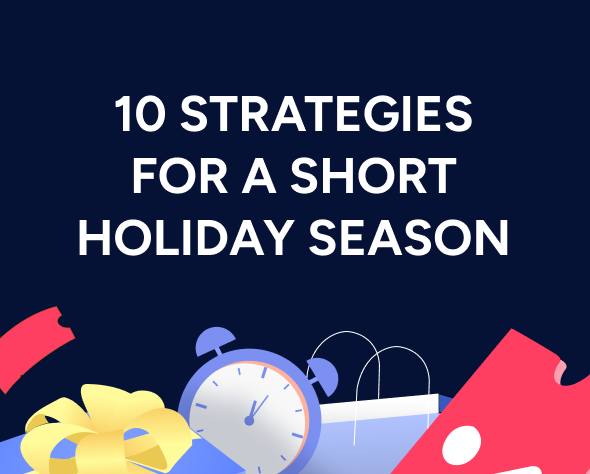5 Expert Predictions for the 2024 Peak Holiday Shopping Season
As we approach the 2024 peak holiday shopping season, retailers are facing new dynamics influencing consumer behavior. To top it off, US inflation rates currently stand at 3%. While trends are shifting, inflation is high, and budgets are tighter, 2024 US holiday sales should still exceed $957 billion.
Updated on 26 Mar 2025
If you’re preparing to capture a portion of these holiday sales, you’ve come to the right place. We’ve compiled feedback from the industry’s top experts, including Chris Baldwin, Eli Weiss, and Kaleigh Moore.

Here are the top five predictions to know this holiday season to help you stay ahead of the curve.
1. Consumers will plan for a shorter holiday shopping season
This year, the holiday season is shorter, with only 27 days between Thanksgiving and Christmas. But know this: the shorter holiday shopping season isn’t holding back consumers.
Tapcart’s 2024 BFCM Consumer Trends report shows nearly 6 in 10 shoppers start their holiday shopping in October or November. And 44% plan their BFCM purchases more than a week in advance.
“The shorter time gap between holidays will have shoppers beginning their holiday shopping earlier, and, with the logistical challenges that present, will lead to delivery issues and backlogs that will be hard for retailers—this can negatively impact the overall customer experience,” says Forbes retail contributor and ecommerce reporter Kaleigh Moore.
To manage customer expectations and keep up with consumer demand, marketers and retailers must prepare in advance for holiday campaigns, secure sufficient inventory, and optimize supply chains for increased efficiency.
2. Budgets will be tighter this year
McKinsey finds that consumers across all generations are trading down. In other words, consumers this year are actively searching for better prices or reducing the number of items they purchase.
But consumers aren’t the only ones facing budget constraints this year. While digital marketing costs are growing, the average marketing budget is falling by 15%.
The challenge for marketers this holiday season will be to maximize ROI despite increased costs and limited budgets. Eli Weiss, VP of retention advocacy at Yotpo, explains how marketers can cope.
“Marketers are looking to cut corners and optimize for profitability. When it comes to retention, most brands will cut the spray-and-pray tactics that cost a fortune and aren’t ROI-friendly and, instead, look for opportunities to put as much focus on the right person as they have put on the right message.”
Weiss also recommends ways marketers can maximize their marketing budgets this year. “Make sure you’re only paying for what you use. Cut bills that make you pay for every customer you have in your data warehouse. Then, start measuring contribution margin by channel and work from there.”
3. Omnichannel shopping will remain popular
Long gone are the days of linear customer shopping journeys. In today’s digital-first world, consumers shop for products across all platforms, making it imperative for businesses to exist everywhere.
“Thankfully, with all of the technology available to merchants in 2024, it’s never been easier to diversify your sales channels. Within weeks, you can set up a Shopify website, create TikTok and Instagram profiles, set up a Google listing, start collecting email subscribers, and even create a mobile shopping experience,” says Tina Donati, founder of ecommerce marketing agency ContentCurve.
While diversifying your sales channels is a must—it’s only half the battle. “You still have to provide a seamless experience to ensure the shopping journey is uninterrupted,” adds Donati.
This means that every touchpoint from your website to your social media profiles must be frictionless and optimized to tell the same story—in terms of your branding, omnichannel holiday marketing copy, visual aesthetics, and overall cross-channel customer experience.
Zack Elias, COO at Reactiv, echoes this sentiment. He says, “A customer might start their shopping journey by browsing products on a desktop website, download the mobile app to get a special offer, receive a push notification reminding them of the products they’re interested in, but then end up completing the purchase in-store. Where they end up purchasing doesn’t necessarily matter—the key is to make sure every sales channel is consistent and personalized.”
4. We’ll see increased mobile shopping
Why should consumers brave the elements when they can do their holiday shopping from the comfort of their living room on their mobile devices? This consumer sentiment is strong in 2024—and supported by several recent studies.
For example, Retail Dive found that 40% of Gen Z shoppers begin their shopping journeys by visiting mobile apps or websites. Tapcart found that 81% of consumers plan to use mobile shopping apps during BFCM. eMarketer reports that US retail m-commerce (mobile commerce) sales will reach $558.29 billion, accounting for 7.4% of total retail sales.
Ecommerce experts believe that marketers are already keen on the rise of mobile commerce—and the ones poised to succeed will prepare to meet customers where they’re buying (i.e., on mobile devices) with outstanding experiences.
“One-to-one mobile-first channels such as SMS and push notifications will be used this year to deliver personalized messages directly to customers, ensuring high visibility and relevance. Additionally, marketers will use strategic QR code placements in packaging and post-purchase surveys to drive mobile app installations and increase mobile traffic,” says Donati.
Marketers who want to reach holiday shoppers should optimize the mobile shopping experience, implement convenient mobile payment solutions (e.g., Apple Pay, Google Pay, and Shop Pay), and incorporate social commerce into their overall personalized marketing strategies.
5. Self-gifting is gaining traction
The trend of self-gifting is gaining traction, according to DigiCommerce, with 61% of shoppers, particularly millennials (73%) and Gen Z (68%), likely to purchase items for themselves while shopping for gifts.
According to Chris Baldwin, VP of Marketing at Insider, “This trend presents an excellent opportunity for retailers to boost engagement through tailored promotions, especially via offers on social where you might also attract new customers, such as buy one, get one free offers, encouraging these buyers to indulge in self-purchases.”
This trend also reflects a broader shift in consumer attitudes. As noted by HappyOrNot, the rise in self-gifting is part of a larger movement towards treating oneself, a behavior that has been amplified by the pandemic as consumers seek comfort and joy in smaller, personal indulgences.
Preparing for success this 2024 holiday shopping season
As economies fluctuate and technology advances, consumer preferences, and shopping behaviors will change.
This past year has been a year of steady inflation, groundbreaking innovation, and unprecedented market shifts. And people are responding in unique ways. They’re making do with limited resources, planning now for a shorter holiday shopping season, and taking advantage of advances in mobile shopping technology.
To meet consumers where they are, review the most recent consumer data, get creative with your budget, and take these expert predictions and holiday season marketing strategies to heart.
Stay tuned for our next blog in the series, where we’ll share the highest-performing use cases for the peak holiday season we’ve seen over the last decade. We’ve taken years of data from messages and personalization to share the best performers that you’ll need during the shortest holiday shopping season we’ve seen in a half-decade.



















